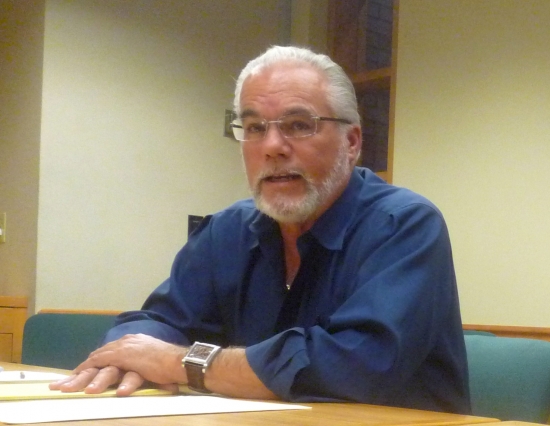
Jordi Gassó Photo
Anstress Farwell raises objections to the plan.
The clock is ticking for two historic buildings on Howard Avenue facing demolition to make way for the new site of a Ronald McDonald House.
A 90-day demolition delay notice, expiring on Nov. 25, was issued last month for 856 and 860 Howard Ave., both of which are listed under the city’s inventory of historic resources.
The Historic District Commission began to hear testimonies last week concerning the pros and cons of allowing the buildings’ demolition. The fate of these structures remained unresolved, though the issue has put the maintenance of New Haven historic buildings on the committee’s radar.
“Tonight’s meeting is the launch of our understanding of the process,” said commission chair Katharine Learned. “We’d like to know more.”
The Ronald McDonald House in New Haven is looking to build a new facility on a lot owned by Yale-New Haven Hospital (YNHH) across from the Children’s Hospital on Howard Avenue. YNHH agreed to donate the land on a 98-year $1 lease. The Ronald McDonald House would pay for the demolitions; YNHH would buy the organization’s current building on George Street.

The owner’s representative and project manager for the new construction, Leland Torrence (pictured), attended the commission meeting Wednesday night on behalf of Ronald McDonald House executives. He argued in favor of razing the historic buildings in question, given their current conditions and deferred maintenance — “demolition by neglect,” he said.

Vision Appraisal
856 Howard.

Vision Appraisal
860 Howard.
According to an independent inspection of the two houses, 856 Howard Ave., an Italianate structure, is “now a ruin inside and out,” with extensive filtration and an inaccessible basement, among other issues. “Could it be moved?” the report asked. “Yes, this structure can be moved, but the economics of the project would probably dictate otherwise.”
On the other hand, 860 Howard Ave. — a modern 1950s office designed by King-lui Wu — was deemed to be in fair condition and fit to be occupied. It was not, however, considered an appropriate candidate for moving due to its long, narrow structure made out of masonry blocks. The two structures are currently being tested for the presence of asbestos and lead.
“I would not consider any of these structures worthy of renovations,” Torrence said at the meeting. “There are better examples that could be saved.”
The Ronald McDonald House has yet to sign the ground lease, Torrence said, adding that the charity would not want take possession of the buildings on the new location unless they can be demolished. The house would accommodate families of children receiving treatment.

Proposed site for the new Ronald McDonald House.
As of yet, there are no floor plans for the proposed building, nor any estimation of its potential footprint. That drew criticism from preservationists such as Anstress Farwell, president of the New Haven Urban Design League, who at the Wednesday meeting advocated for a more calculated approach in planning the development of the new site.
“In an ideal world, these historic buildings should have been taken care of,” she said in an interview.
While Farwell concurred with the assessment of the two buildings’ disrepair, she lambasted YNHH for “land-banking” these properties — in other words, letting them sit unattended and degrade.
YNHH spokesperson Vin Petrini told the Independent that many properties in the area had been in a state of disrepair before the hospital acquired them; he added that YNHH nevertheless takes responsibility for their conditions. Now, he said, the hospital is seeking to provide an opportunity for families in need, one that is “consistent with the values and interests of the neighborhood.”
Farwell, along with John Herzan, an officer for the New Haven Preservation Trust, also raised concerns about the project’s plan to cross through the block from Howard Avenue to Vernon Street. They argued the plan could alter the integrity of the surrounding residential area.
“We were concerned about the design which is still very schematic,” Herzan said at the meeting. “Nothing definite about it would fit into the neighborhood.”
“It’s a shame the area couldn’t maintain its streetscape,” he added.
Torrence, who said he has been collaborating with Farwell on how to best handle the demolition, described the issue as an interpretive one. He said the neglected buildings should be torn down regardless of the next step; Farwell said no permissions should be given until there is a suitable plan in place for the new structure.

Matters of zoning and planning, though, do not fall under the jurisdiction of the Historic District Commission. The commissioners leading the meeting said that their role is to issue an opinion on whether they consent to the demolition of these historic buildings.
A committee — composed of experts, community members and officials from YNHH and the Ronald McDonald House — is in the process of being formed to consult the design of the new site, Torrence said.
The Ronald McDonald House hopes to break ground by June 2015, he said. Approval of the demolition, he argued, would not only further the Ronald McDonald House’s charitable goals but also deliver the Hill from a physical blight in the area.
“If an owner owns a property and they don’t want to develop that property, that’s their business,” he told the Independent. “I’m not here to criticize what people have done in the past. I’m here to look forward.”